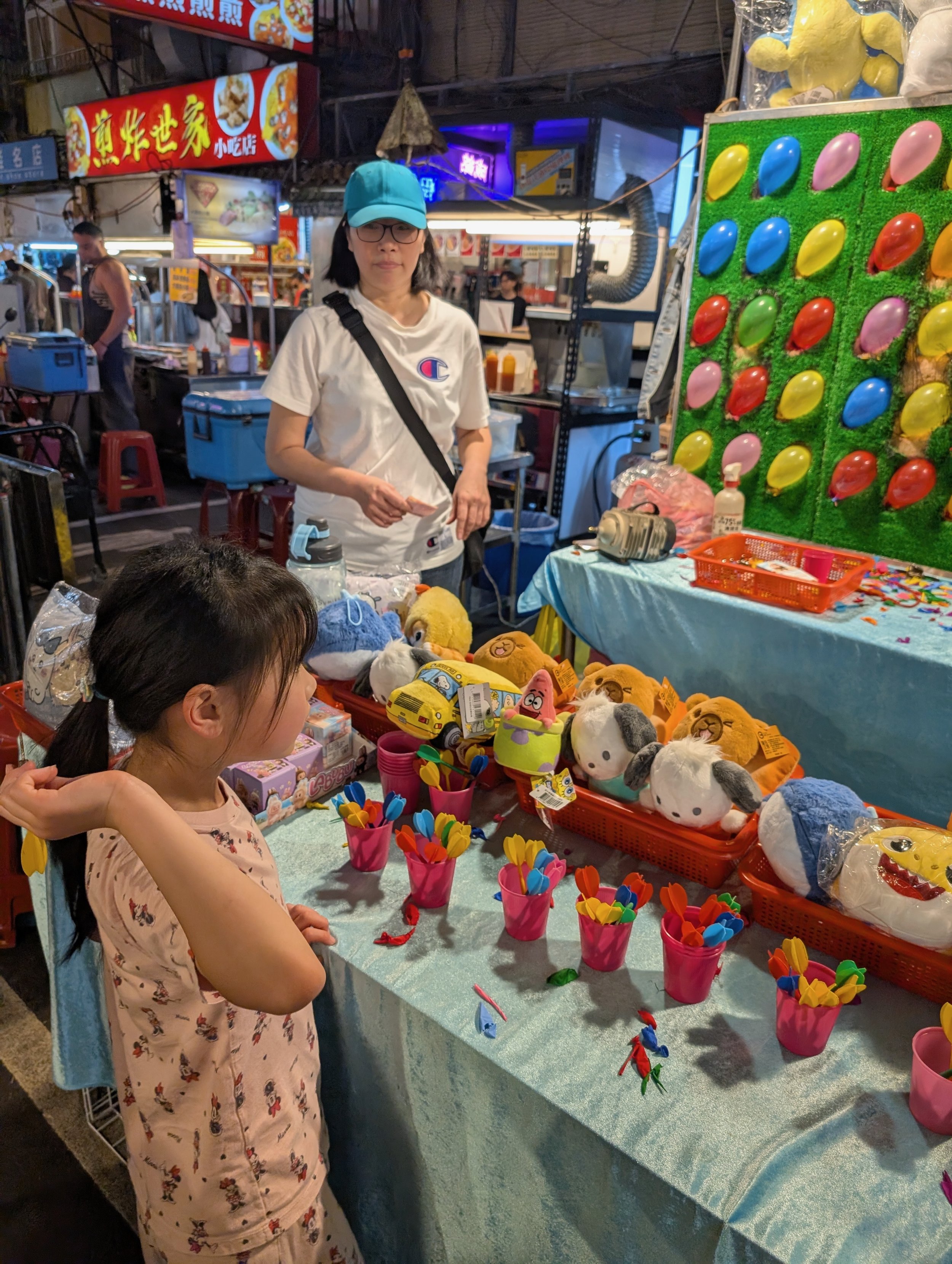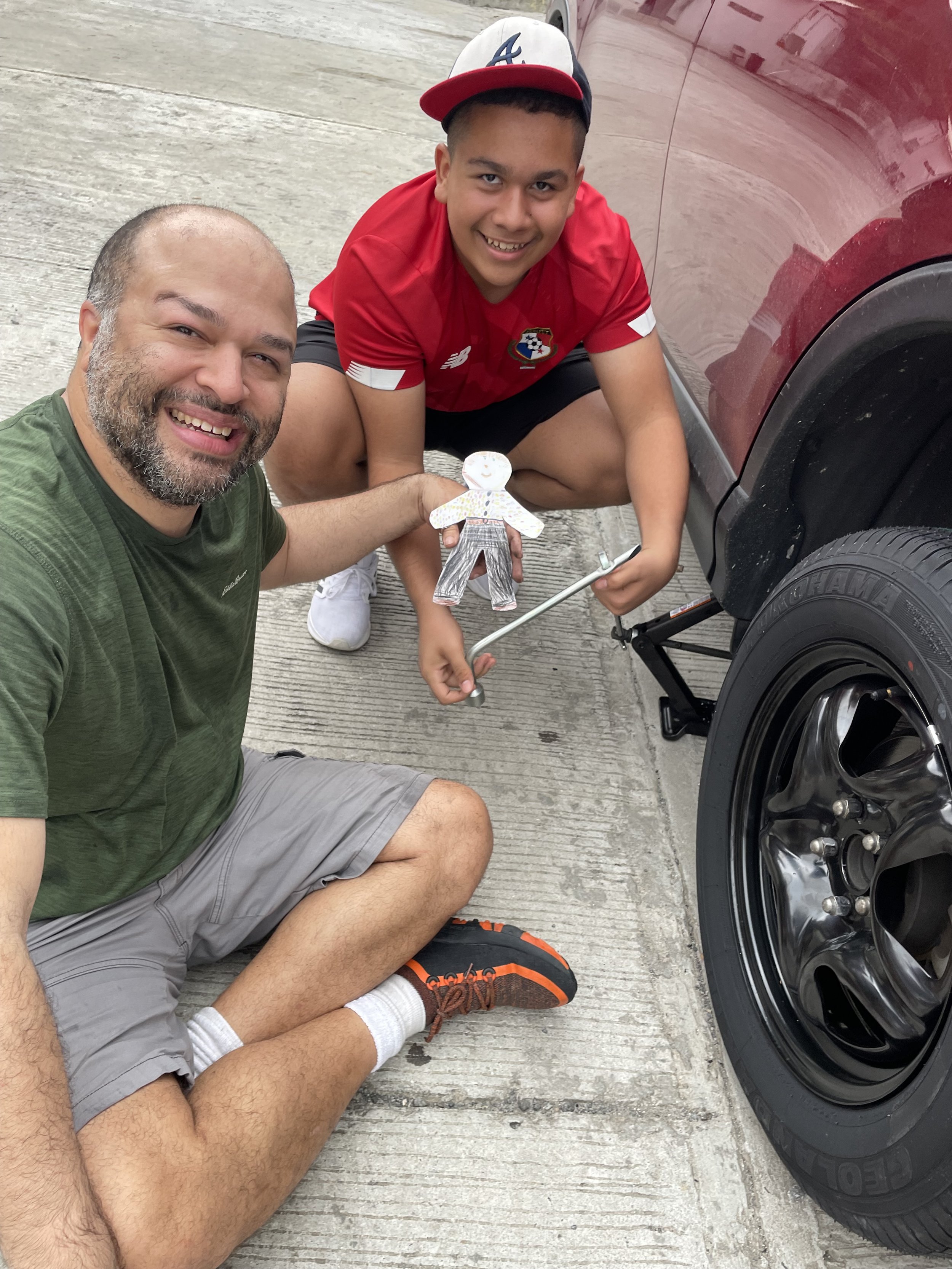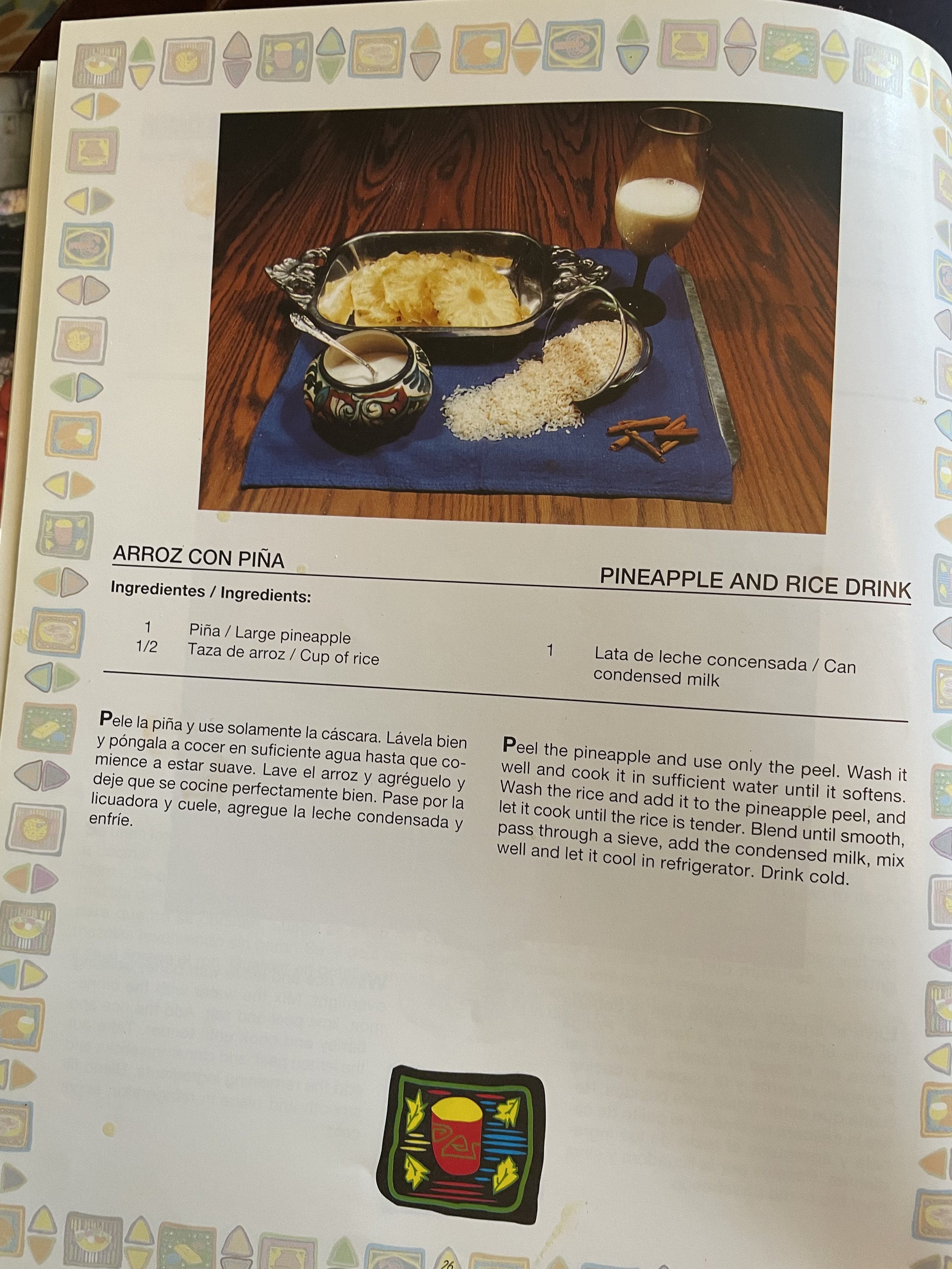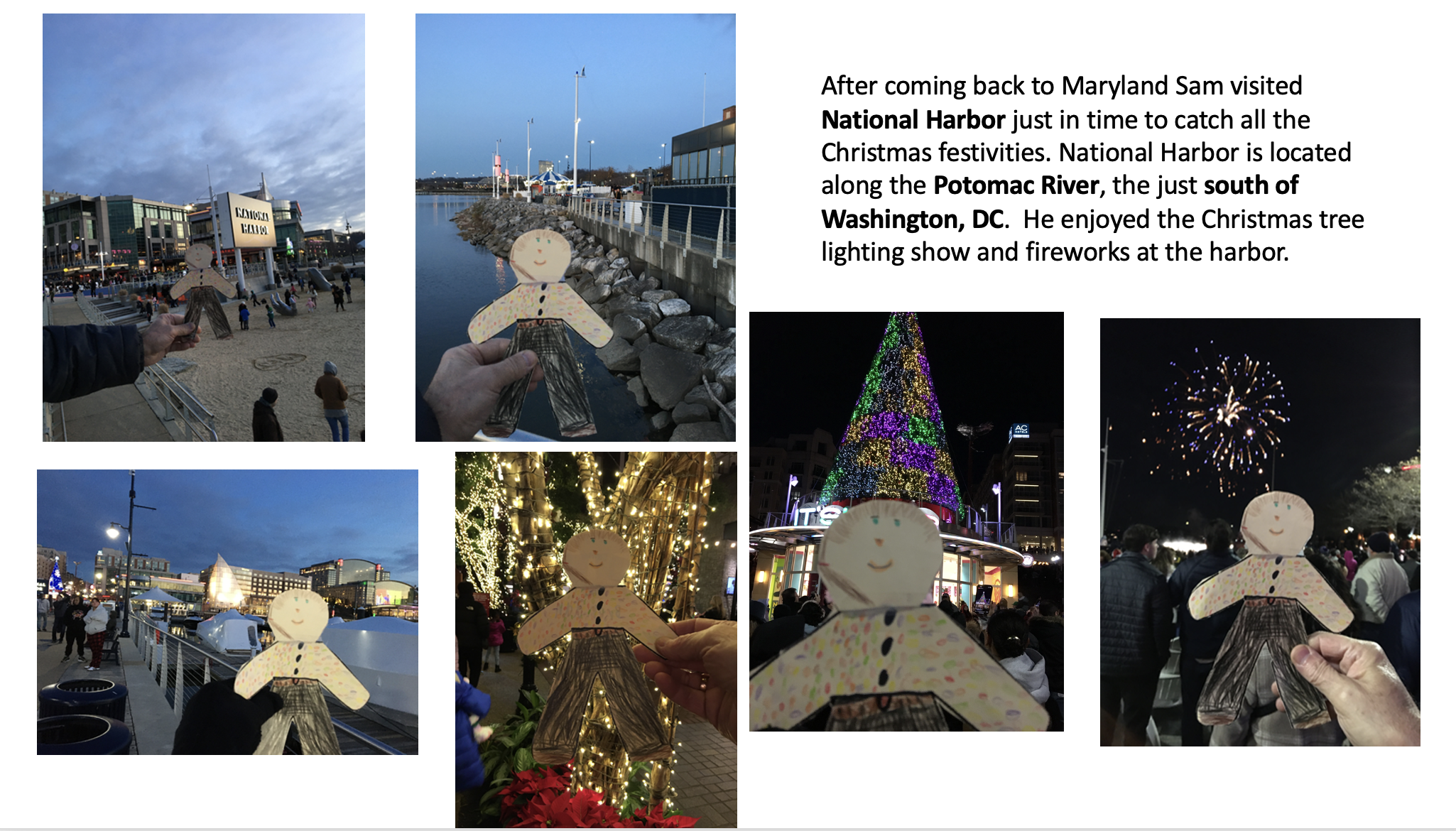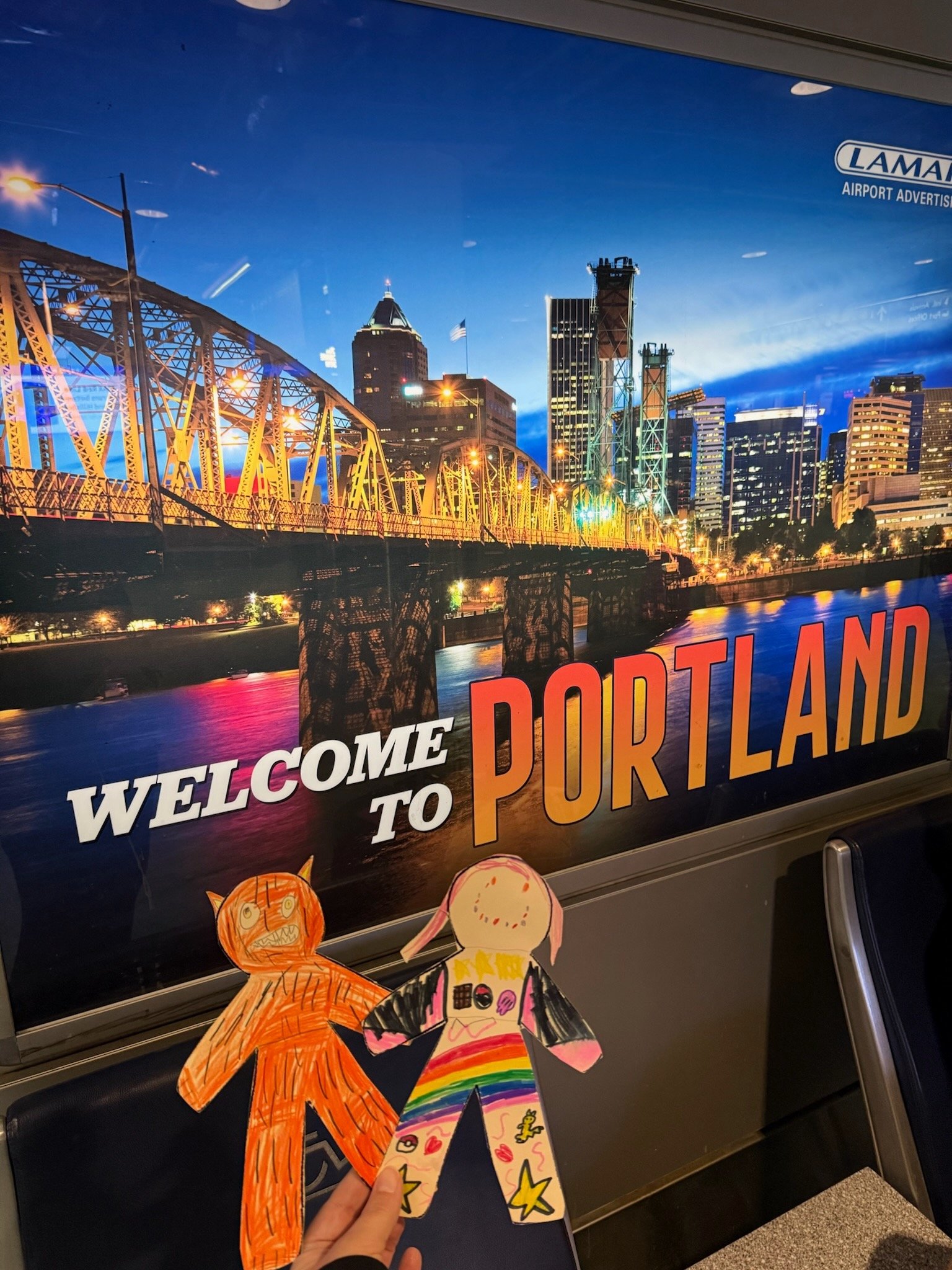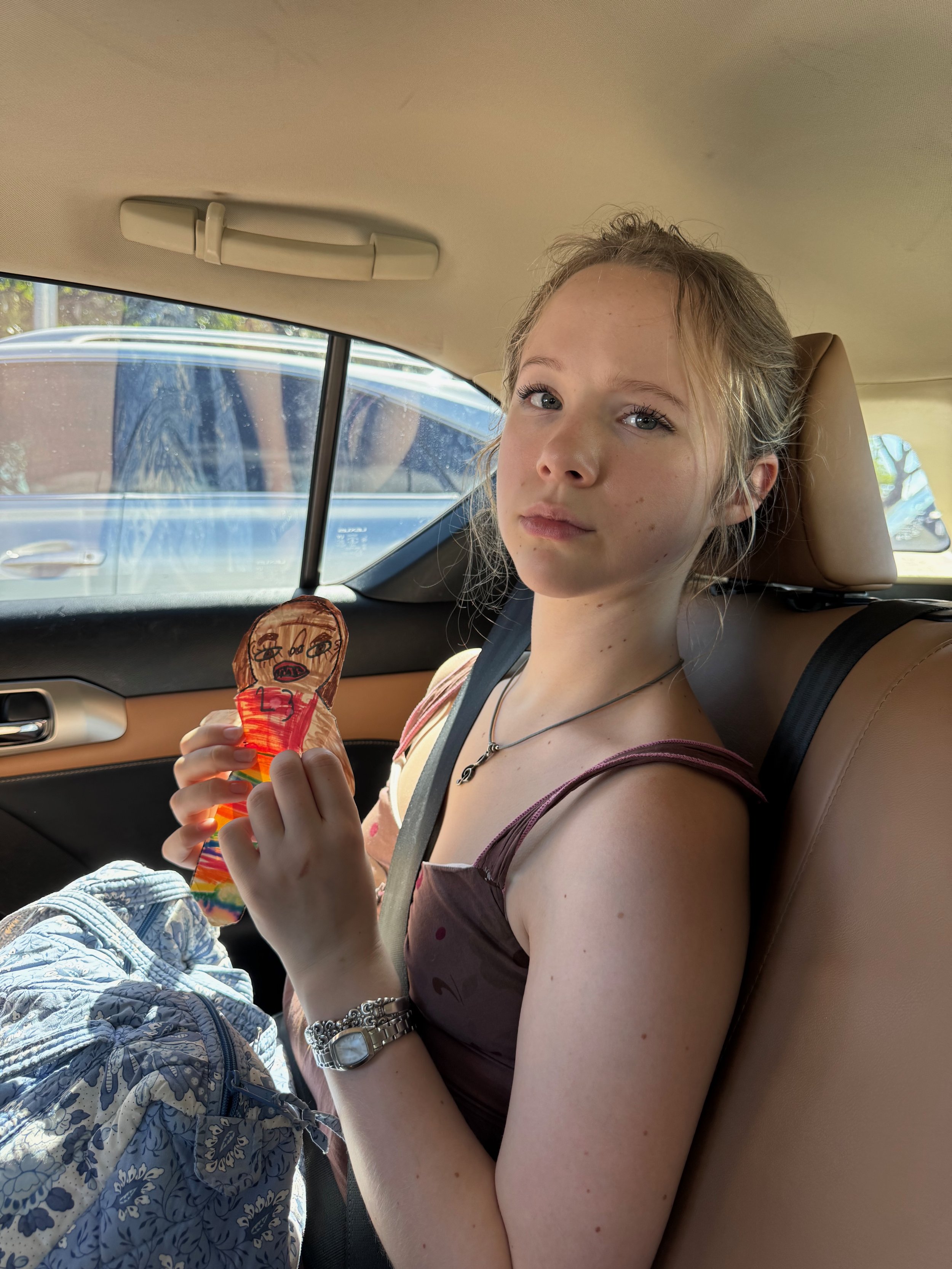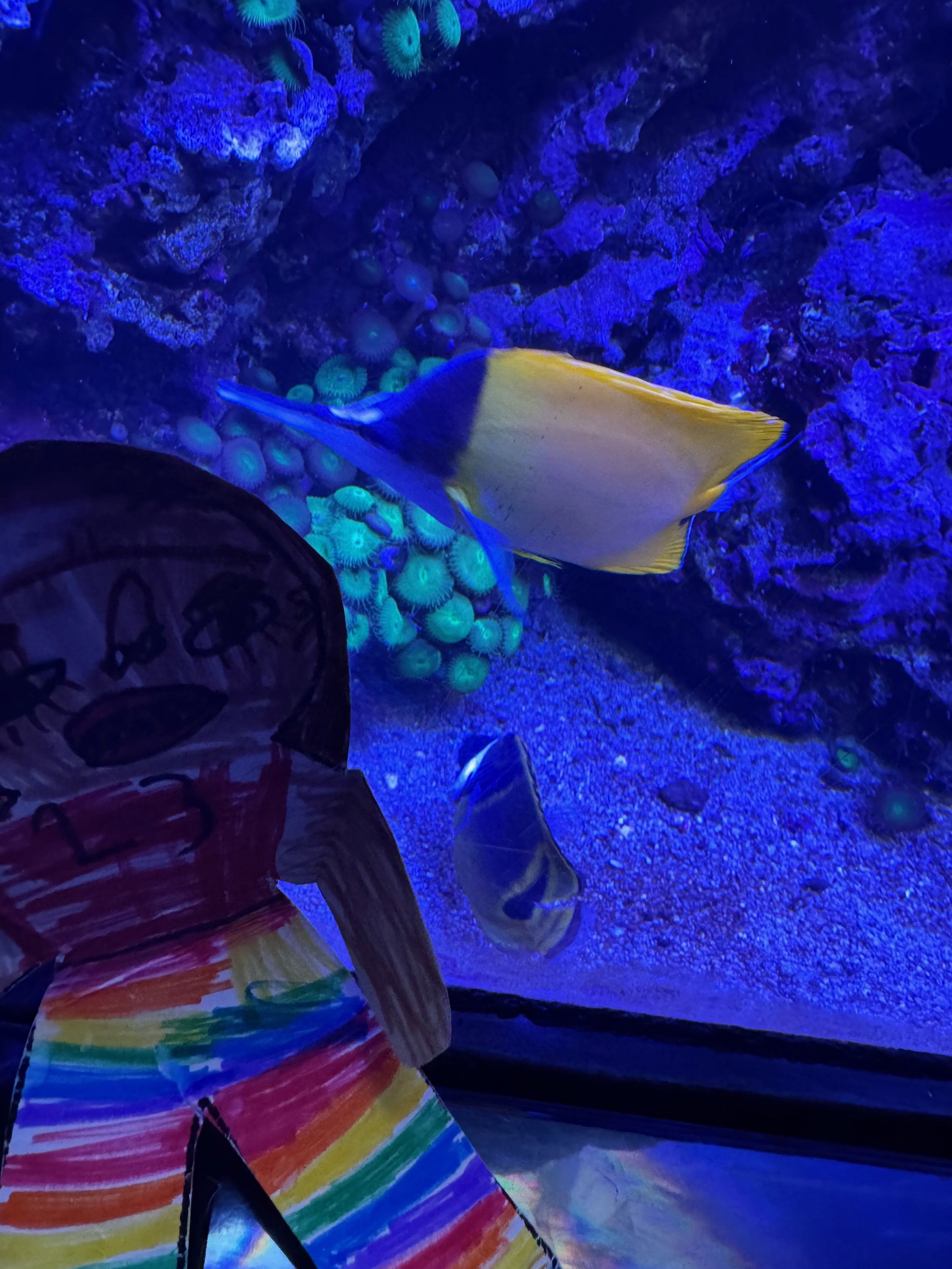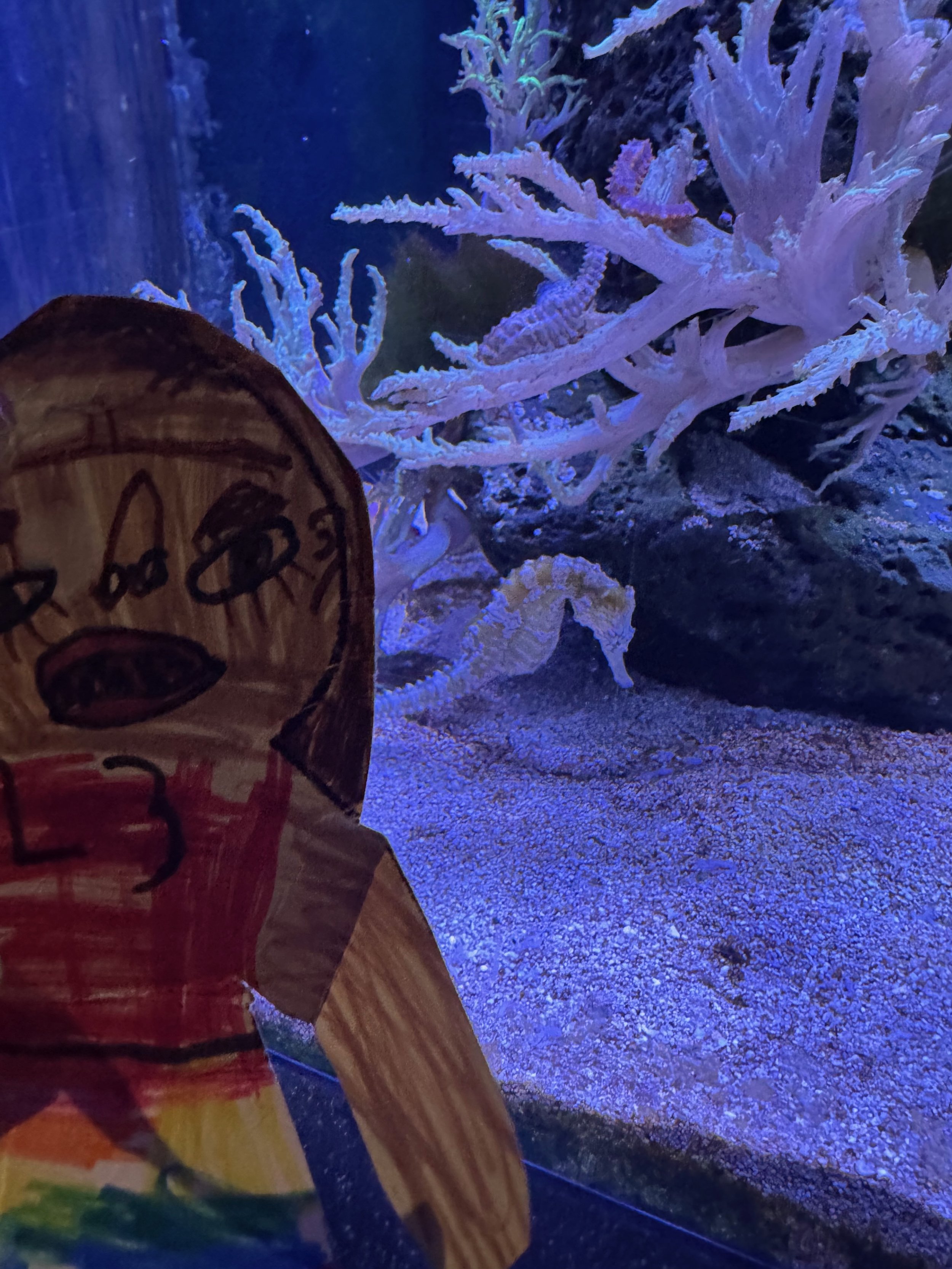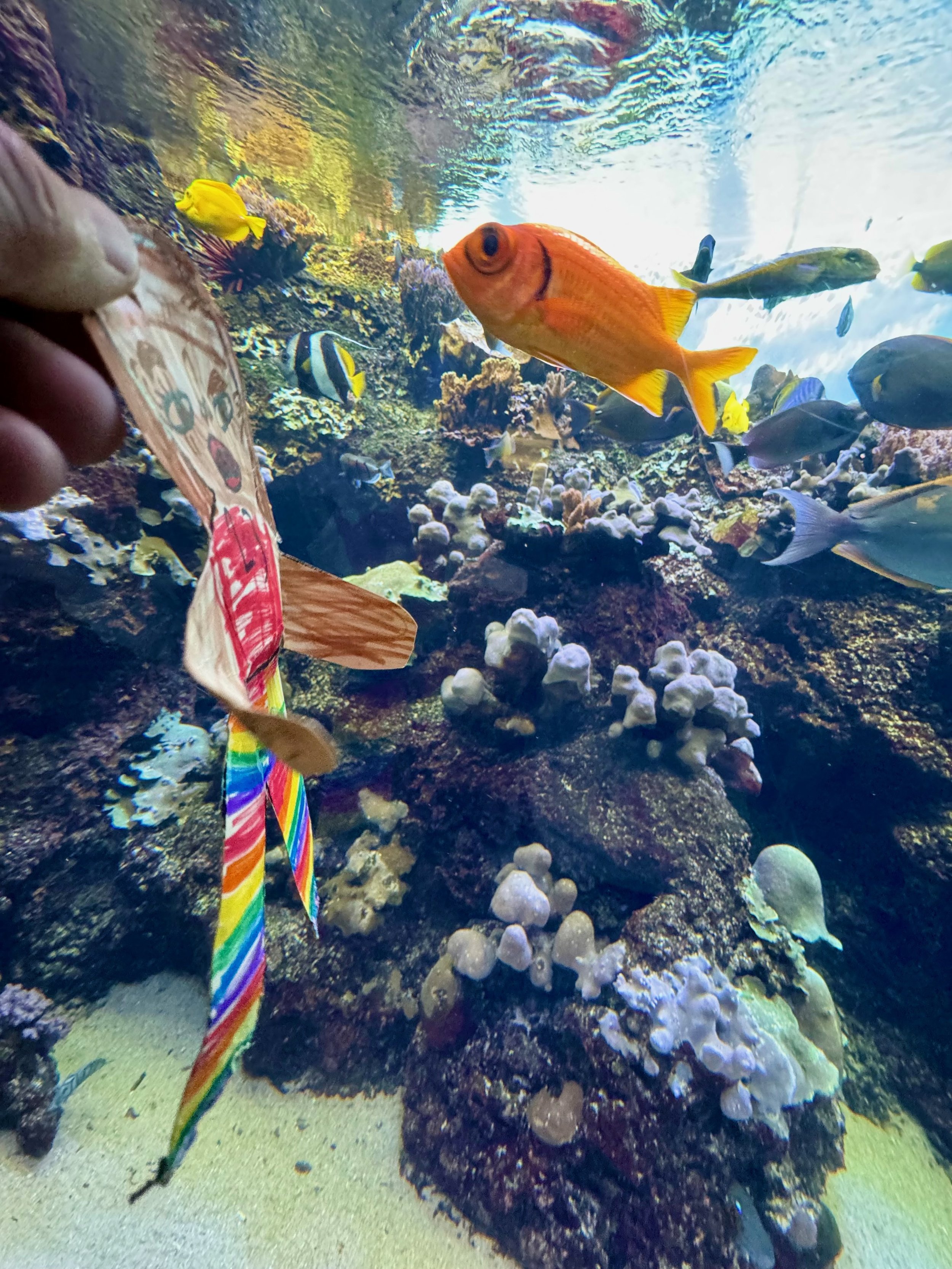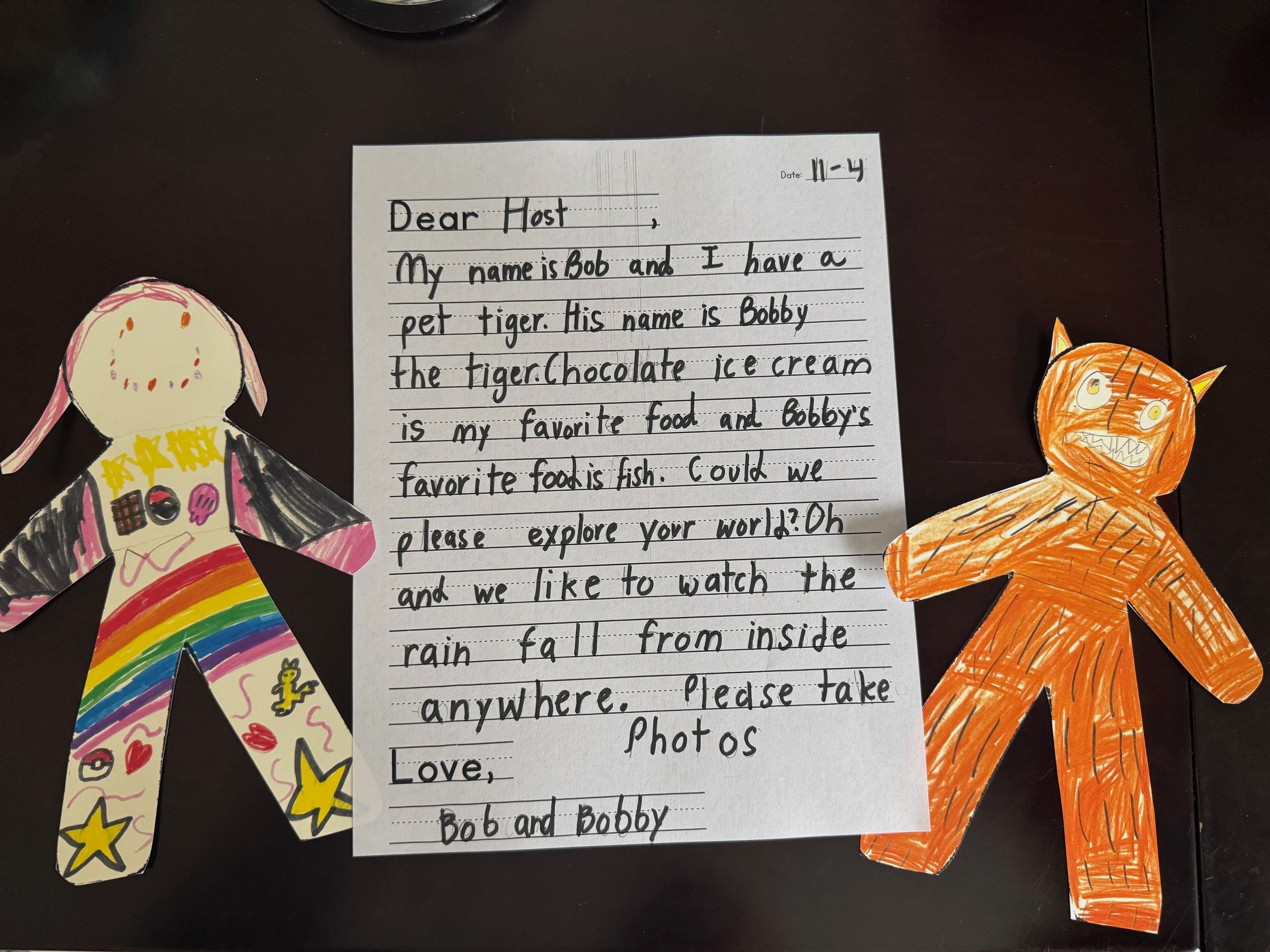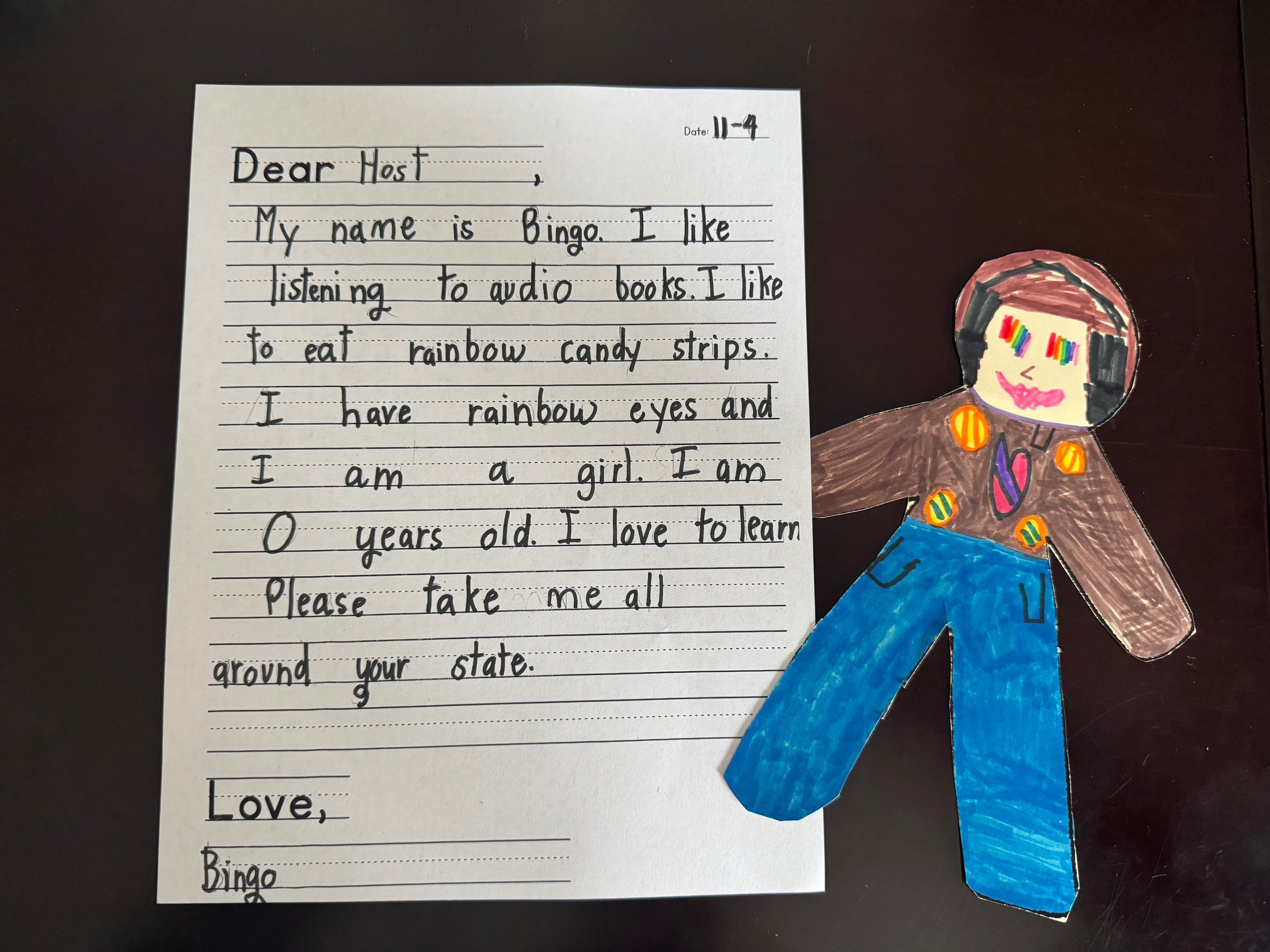Flat Sam in Panama
/Dear Ms. Aja's Otters!!
Flat Sam asked me to share about his vacation to Panama over the holiday break.
First, he got on an airplane and took a flight from Portland to Los Angeles. Then he took another airplane to Panama City, Panama (which is the capital of Panama). Panama is a small country at the very bottom of Central America. It is like a bridge between North and South America. The most common language spoken is Spanish.
It was so hot and humid when Sam got off the plane. Every day in Panama is around 90 degrees F! And it never gets really cold. Panama has a very tropical climate and it has beautiful rainforests, mountains, beaches, and islands with palm trees and orchids.
Sam was hot and tired but so excited for his Panamanian adventures! He went on a car ride to a beach called Coronado. It was about two hours by car from Panama City. He swam in the pool and played in the sand of the Pacific Ocean.
During the trip, the car got a flat tire. Flat Sam knows all about flatness, so he was happy to help change the tire on the car.
Flat Sam was visiting at a very eventful time of the year. December is the beginning of the summer (the dry season) in Panama. Panama really only has two seasons - wet and dry. In December, the school year ends and kids are on vacation. Most people also celebrate Christmas and New Year’s, so there are parades and parties.
Sam also got to participate in making tamales on his visit! Tamales are a traditional food made from ground corn mixed with peppers, onions, meat, olives, and capers then wrapped in leaves and tied with a string. Making tamales is a time-consuming effort, so they are usually just made at the holidays.
Sam enjoyed cooking and eating all of the amazing food in Panama! He especially enjoyed the many rice dishes, fish, chicken, ceviche, plantains, and papaya and mangoes. He also sent you a recipe for Arroz con Piña- which is a delicious and refreshing drink made from rice flavored with pineapple.
Panama is a country that is sandwiched between two oceans: the Atlantic and Pacific. And it has a very famous canal that connects the two oceans. Sam did not get to visit the Panama Canal on his trip, but he is excited to go there in the future.
Panama City is a town that is many centuries old. Sam traveled to the ruins of old Panama where you can climb a tower from the 1500s. Panama City is also a very modern city. Sam spent some time at the mall and went bowling on his trip.
Sam finished off his trip with a New Year’s party where there was loud music, delicious food, and lots of new friends along with hours of salsa dancing. Sam enjoyed his time in Panama so much that he decided to stay there a while longer to practice his Spanish and enjoy the summer!
TTT Explores King Tides in Washington
/I picked up Juliette’s flat Stanley for my trip and was surprised because, while definitely flat, this was not a boy named Stanley but a girl named Tens Twenties Thirties (TTT)! I was glad to have a colorful companion on this photo expedition & taped her to a mini tripod where she could stand on her own. I then covered her with tape as a raincoat since it was due to rain, and we set off for Cape Disappointment in Washington state to photograph king tides. Here she is ready to go.
Now, sometimes photographers have to do unusual things to get their pictures, and this was one of those times. The high tide our first day was at 7:30 AM; to see the biggest waves one has to be there 2 hours before high tide, and the coastal site for the pictures is two hours away. So…TTT, Bindi and I set out in the middle of the night, 3:30 AM while most everyone else was sleeping and it was pitch black dark. It was a foggy drive but, we managed to arrive at our site, Cape Disappointment, just before sunrise. It was an unusual clear day so we saw beautiful colors during what’s called the blue hour - the hours before dawn when the sky is a very dark blue and orange reflecting the coming emergence of the sun still beneath the horizon. Here’s how it looked. Pretty beautiful!
But good weather meant no great big waves from king tides so we coped with disappointment at Cape Disappointment because there wouldn’t be many pictures of big waves for TTT to bring back and show you. We decided we’d just try to make the best of it. There were 1 or 2 big waves as you can see here.
Then, since my dog Bindi accompanied TTT and me we took her on a walk. Along the way we happened upon some interesting sights…views of the Pacific Ocean
and fungi growing on the path and in a tree. First we found Turkey Tail, almost as colorful as TTT. Next we saw Chaga, a big knot on a tree branch.
We wanted to tell you a bit about where we were.
Did you know that rivers have a mouth? They do, the place where the river ends and releases its waters into another larger body of water like a lake or the ocean. Cape Disappointment , where we were, is in Illwaco, WA , a town at the mouth of the Columbia River where it ends at the Pacific Ocean. We got here by driving to Oregon’s most northwest town, Astoria, and crossing a bridge to reach Washington State. Illwaco and Cape Disappointment State Park are 14 miles north of that bridge.
The mouth of the Columbia is one of the most fearsome stretches of water in the world, known for centuries as the “Graveyard of the Pacific.” By one estimate, more than 2,000 ships have been wrecked here since record keeping began in 1792. The reason, according to Captain Mark Hails, who is based in Astoria, is simple: the convergence of four elemental forces—wind, waves, tides, and currents—creating a vortex of energy that poses unique dangers to shipping.
Hails is a Columbia River Bar pilot, a highly trained expert at guiding container ships and other giant vessels through the waters that swirl around the sand that guards the river’s mouth. Inbound or outbound, when ships need to cross the bar, they rely on Hails and his 14 fellow pilots to take command of the bridge and steer a safe passage.
The hazards are the stuff of legend: breakers 40 feet high, howling winds, relentless currents, and treacherous tides. To maintain control of the vessel, pilots have to balance these vectors with the precision of a gymnast executing a double backflip. “The problem is that each force pushes a ship in a different direction,” Hails says. “That’s what makes this so crazy.”
Columbia River Mouth and Bar (Wikipedia)
The Columbia is big by any standard: It drains an area of a quarter-million square miles, including most of Oregon, Washington, and Idaho, and much of Montana, British Columbia, and Alberta. What makes it so dangerous is its unusual geometry. Most big rivers terminate in deltas, where the river splits into hundreds of distributaries, like a fraying rope. The Amazon, the Mississippi, the Nile, and the Mekong have deltas that are hundreds of miles wide, dissipating the flow.
The Columbia is different. Hemmed in by implacable basalt cliffs, the water is confined to a single channel. Making matters worse, it narrows at the mouth, where Clatsop Spit in Oregon and Washington’s Cape Disappointment come together like a carpenter’s vice. Following Bernouilli’s Law, which states that a fluid flowing through a constriction will accelerate, the river picks up speed and comes blasting through the mouth with unmatched fury, throwing about 7,500 tons of water at the Pacific Ocean every second.
“It’s like putting your thumb on a garden hose,” Hails says. “There aren’t many rivers in the world with a current that strong.”
As the current speeds up, it dumps sediment on the ocean floor, forming a kidney-shaped sandbar a couple of miles offshore. This bar triggers the opposing force—the Pacific swell. Waves born off Japan’s coast grow in strength as they travel across the Pacific, gaining momentum from ocean storms. When they encounter the sudden shallow water at the bar, they break and detonate, hurling their pent-up energy straight into the swift river current. Throw in the unpredictable effects of storm winds and turning tides and you unleash the monster.
Columbia Bar shipwrecks map (NW Power and Conservation Council)
Trying to Tame Nature
“Mere description can give little idea of the terrors of the bar of the Columbia,” said Captain Charles Wilkes, whose sloop, the USS Peacock, was shipwrecked near Astoria in 1841. “All who have seen it have spoken of the wildness of the scene, and the incessant roar of the waters, representing it as one of the most fearful sights that can possibly meet the eye of the sailor.”
With its constant shifting, the bar claimed so many ships that Congress intervened. In 1884, the U.S. Army Corps of Engineers began construction on a massive jetty to protrude into the Pacific from Clatsop Spit. A second jetty was added in 1914. The jetties were designed to concentrate the flow of the river like a firehose, scour the riverbed, and push the bar away from the mouth.
The jetties helped—today the bar is more stable and lies farther offshore—but hardly tamed the monster. Crossing the bar is still perilous, especially for marine giants like container ships. These vessels need deep water—about 43 feet of draft. The only safe passage for them is to stay true to a narrow shipping channel that runs along the deepest course of the river, which is 600 feet wide. If they stray into shallower water, they risk running aground on the riverbed and getting spun like a pinwheel. That’s more or less what happened to the Ever Given, which got stuck like a chicken bone in the Suez Canal in 2021, or the MV Dalí, which demolished Baltimore’s Key Bridge earlier this spring.
Given a couple of million years, geologists predict the Columbia will settle down and develop a delta. In the meantime, let’s treat the river with respect. It is a phenomenal force whose true depth lies hidden beneath the surface.
Illwaco, the town located near here, is a small town, population approximately 1000 people in winter, 3000 in summer due to tourism.
Fishing and crabbing are the main industries here in addition to tourism. It’s a prime spot for catching salmon because it’s close to Marine area ! In the ocean, As we drove through town we saw many crab pots and boats both on land and in the harbor. Because of Cape Disappointment shipwrecks Illwaco residents have a long history of rescuing shipwrecked boats and people , salvaging goods from the ships, and carrying home crates of goods that washed ashore. Nowadays the residents are accustomed to the arrival of large groups of photographers during winter when king tides occur.
What is a king tide and what causes it? The scientific name for a king tide is a perigean spring tide. "Perigean" means the moon is at its closest point to Earth, and "spring" refers to a new or full moon. The gravitational pull of the moon is about twice as strong as the sun's, so when it’s this close to earth it adds to the sun’s gravitational pull creating extra strong tidal forces causing king tides. These occur once or twice a year and usually the waves are 2 or more feet higher than usual high tides. They can cause flooding and can be dangerous so we must watch them from a safe distant spot. Oregon and Washington usually have 3 episodes of King Tides between November and January. TTT and I saw the January ones between the 10th and 13th. While usual high tides are 5-7 ft, these were expected to be above 9 1/2 ft. However, they only get this high at the shoreline when there are higher winds and ocean swells which were not happening when we arrived. So we saw a few large waves crash onto the rocks but nothing too dramatic. Here are pictures of 2 information displays we found at the cape .
And here’s a picture of an old shipwreck still on the beach at Fort Stevens State Park.
We finished our first day of pictures and exploring so it was time to find our Airbnb room which meant a trip on the Astoria bridge which crosses the Columbia River and returned us to Oregon for the nite. It was a nice place. Here are TTT and Bindi trying out their bed for the next 2 nights.
We returned twice more to high tide at Cape Disappointment on the next 2 days and finally on day 3 we got terrible weather with winds and ocean swells so the waters were churning with giant waves crashing into the shoreline. Even though it was pouring rain, more than 50 photographers crowded the shoreline and it was challenging finding a good spot to watch the action! But we climbed up on a mountain of driftwood and got a few pictures to share with you. One thing’s for sure, you don’t try to go swimming in waters like this! King Tides have been known to wash careless people out to sea, so we kept our respectful distance. In some pictures you can see the waves growing bigger and bigger until they are almost as high as the cliff behind them. That is a king tide wave. TTT stayed in the car for this part. It was too windy and rainy for her to be safe out in the weather.
Finally we dried off and returned home. It was good to get out of the wild weather but we’ll go back next year in hopes of finding even wilder, bigger waves!
T³ in Santa Fe
/Dear Otters,
This is Poppy and Mimi, two of Juliette’s grandparents, writing about our recent, short trip to Santa Fe, New Mexico during the holidays.
We arose early the Monday morning before Christmas Day to fly from Seattle to Albuquerque, New Mexico, where we took a shuttle to our hotel. Before telling you about our adventures, let us share some facts comparing Oregon and New Mexico. See the table below.
We arrived at our Santa Fe hotel, the El Sendero Inn, around 5pm, tired from our plane flight and shuttle PLUS we were hungry. Off we went to the Coyote Café! And we FORGOT Tens, Twenties, Thirties, which we will call T3 or T-cubed (T³).
Otters, in mathematics, to cube a number means to multiply that same number three times. For example, 2³ means multiply the number 2 three times – or 2x2x2. Two times two equals four, which multiplied by two equals eight. So, 2³=8. [Ask Ms. Aja about “powers” for more information.]
UGH! We were so hungry!
So, about 5:15, we arrived at the Coyote Café. Two stories tall, with fine dining on the first floor, more casual dining on the second. Serving New Mexican cuisine, which combines Mexican, Native American, and Spanish traditions. The upstairs walls were painted everywhere in bold colors. The restaurant was booming, hopping. See the pictures below!!!!!
This experience got us thinking about coyotes. Otters, did you know that:
Their scientific name is Canis latrans.
New Mexico has the 5th largest coyote population in the United States [about 125,000 coyotes]. Oregon is in 9th place in terms of population [about 83,700], while Texas leads the nation with around 859,500 coyotes.
Coyotes generally have a lifespan of around 10-14 years in the wilderness and in captivity, they can live up to 18-20 years.
The Lewis and Clark expedition [1804-1806] is often credited with the discovery of the coyote, but it’s important to know that coyotes were known long before to Native American tribes and Spanish settlers. In fact, the name “coyote” comes from the word “coyoti” used by the Aztecs.
Coyotes are fast runners, capable of reaching speeds of up to 40 miles per hour.
While often seen alone, coyotes can form small family groups. They typically have a mate for life and work together to raise their young.
They often hunt in pairs or small groups to catch their prey.
[Thank you, Artificial Intelligence, for this information!]
What a way to start our evening eating at Coyote Café. Then, walking back to the hotel, we chanced upon Santa Fe’s central square or plaza; it was ALL lit up!!!!!The trees. The truck. Cars passing by. What a way to begin the holiday season. See the pictures! We did not forget T-cubed again!!!!
The next morning began the day of Christmas Eve. While we did various activities during daylight, the spectacular part was the evening when we walked along Canyon Road.
Canyon Road in Santa Fe is a famous art district known for over a hundred galleries, boutiques, and restaurants. A half mile in length, it showcases a wide range of art, from traditional to contemporary. On Christmas Eve, Canyon Road hosts a beloved tradition called the Farolito Walk. Thousands of people gather to walk along the Road, which is illuminated by thousands of farolitos [small paper lanterns] and luminarias. The atmosphere is festive, with carolers singing, families and friends strolling together, and the glow of the lights creating a magical holiday experience. What FUN! See the pictures, ALL with T-cubed!!!!!!
Christmas Day was spent with family – Juliette, Ren, Claire, Zach, Bea, Matt, and Nick – and cold, clear, and even lightly-snowing weather in the late afternoon.
The day after Christmas we were on our own, as most family members, including Juliette, went skiing. We decided to visit 2 museums, one in the morning, the other in the afternoon. Both were FABULOUS. The morning one was the New Mexico History Museum, full of interesting exhibits related to the origins and development of the state over time. We learned about early immigrant families, about land grants to early Spanish and Mexican settlers, about the conflicts with Native Americans over land rights issues, and so on. We have attached pictures from different angles of an actual stagecoach [from the 19th century, I believe].
Onto the Georgia O’Keefe Museum we went in the afternoon! Otters, Georgia O’Keefe was a very famous artist who was born in 1887 and died in 1986. In the late 1920s she began to travel to New Mexico where the desert landscapes had a profound impact on her work; she permanently moved there in 1949. Among the many honors and recognitions she received was the Presidential Medal of Freedom [1977], the highest civilian honor in the United States. T-cubed is pictured with some of her paintings. Over 1.7 million people have visited the museum since its opening in 1997.
The next day we learned of high winds, tornadoes, heavy rain, and other inclement weather happening throughout the United States, and Poppy feared that we would be delayed flying home. In fact, over 800 flights were canceled on Thursday. The good news is that our Friday departure was on time, and we landed without delay at SeaTac, the nickname of Seattle’s airport.
A fun and happy holiday was had by all!!!!!!
HAPPY NEW YEAR, OTTERS!
From Poppy and Mimi – and Juliette
Questions for the Tens, Twenties, Thirties Team to Research
1. What are land grants?
2. Santa Fe is high above sea level. How high is it, and how does its height compare to the height of Forest Grove?
3. Oregon is in the Pacific Standard Time zone and New Mexico is in the Mountain Standard Time zone. How many times zones are there in the United States, including Hawaii and Alaska, and what are they?
Student Answers on January 27th, 2025:
Dear Poppy and Mimi,
Today we got to research the answers to your questions with one of our guest teachers. Here's what we discovered:
A land grant is a gift of real estate. Real estate is a person's property. Grants were given to people to grow and bring new people to New Mexico.
Santa Fe is 7,198 feet above sea level. Forest Grove, Oregon is 203 feet above sea level. Santa Fe is like being high up on a mountain compared to Forest Grove!
We learned that there are six time zones in the United States. 4 major time zones plus HI and Alaska. The time zones are: Pacific, Mountain Time, Central Time, Eastern Time, Hawaii, and Alaska. Some of us have gone on trips to other places and have had to adjust to the new time there. One of our classmates recently got back from Florida and there was a three hour time change when he flew there.
Thanks for taking T-Cubed on adventures and for teaching us new things!
Love,
Juliette and the Otters
Flat Bingo in Utah
/Dear Class,
Thank you for letting us, the Burbidge family, host Bingo over the holidays! She had a lot of amazing adventures in Utah. When she first came to town, we walked her around downtown Salt Lake City, showing her our light rail train called TRAX and some of the old historic places. She even climbed some of the scaffolding!
It may be hard to believe, but downtown Salt Lake was created in 1847. So Bingo saw a few pretty old buildings! She also took in the entire city at night time -- when she squinted, she could see the Great Salt Lake in the distance. But Bingo was more interested in seeing the Nutcracker, a favorite holiday ballet around here, than looking at buildings. Unfortunately, they don't allow photography in the auditorium, so we took a picture by the sign instead! She seemed mostly entertained, although the dance of the Sugar Plum Fairy put her to sleep a little bit.
Bingo also wanted to know when Santa would be coming -- we told her that at our house, he comes the night of December 24th. She was very excited to hear that and helped open a few presents in the morning. Bingo also met two very friendly puppies while visiting, and fed them some tasty treats.
Bingo's biggest adventures were, of course, in the snow! She went up skiing twice during her visit. Once on a sunny day, and once on a windy and snowy day. She enjoyed skiing fast both times! Her favorite ski resort was Alta, which has 2,600 acres of terrain and the tippy top is at 11,000 ft above sea level. That's pretty high. Bingo skied green, blue, and even black diamond runs. She was a natural...as long as the wind wasn't too strong.
At the end of her stay, Bingo made some snow angels, took a stab at shoveling snow (it was very heavy), and then enjoyed a warm cup of hot chocolate for all her work. (Rosalind helped her drink what she didn't finish.)
It was such a delight to have Bingo as our guest. We hope that she inspires people to come to Utah some time! It's a beautiful place to live.
Warmest,
The Burbidges
PS. We wanted to share Graham's recipe for what makes a good friend.
Bob and Bobby in Tokyo, Japan
/Bob and Bobby in Tokyo
Jan Update: Flat Robot in Hanham, United Kingdom
/Tuesday 6/1/2025.
Happy New Year everyone,
I hope that you all had a wonderful Christmas and that you are ready to work hard and have lots of fun this term.
We all went to London for Christmas. We stayed with Finn and Jasper’s auntie and uncle and their little boy.
One evening we all went into the west end of London to see the Christmas lights. One shop had even been turned into a giant advent calendar..
We had special Christmas food to eat including a big dinner on Christmas Day. We had roast turkey with two types of stuffing, carrots, Brussels sprouts, roast potatoes, parsnips and gravy. There were Christmas crackers on the table. Two people have to each take an end of the cracker. They each have to pull hard until the cracker goes bang and breaks in half. Inside each cracker was a small present, a party hat and a piece of paper with a joke written on it. My joke said :
“Why are Christmas trees so bad at sewing”?
(Answer) “because they are always dropping their needles”.
I will write again soon
J-robot
Tuesday 20/12/2024.
Dear Otter class, I am sorry that I have not written to you sooner. We have been getting ready for Christmas. We have been shopping for presents, writing Christmas cards and baking. On Sunday it was dry so we walked along a country lane to church. The church is very old. It was built in 1380. There is a big house next to the church, they were both originally part of a monastery but now a family live in the house. The church was not very warm, I am glad I had my scarf on. The minister was very friendly. He wears special clothes when he takes a service. When we got home after church I helped grandma London make some cakes called flapjacks. They were yummy! I hope that you are all having fun getting ready for Christmas. I will write again soon J-robot
Tuesday 3/12/2024.
Dear Otter class,
Today grandad London suggested that we go to the Bath Christmas market. I ran upstairs to the bathroom but I could not find a Christmas market in the bath!
Grandad London explained that Bath is a very special city. It is 18 kilometres (11 miles) from Bristol. It is an UNESCO World Heritage Site. It is called Bath because there is a hot water spring there.
The Romans liked the hot water so much that they built some large baths and a temple there in 60 A.D. The baths are still there today. I took a quick swim when no one was looking.
More people moved to Bath. In the 12th century they built an Abbey which is still standing today.
In the 18th century Bath became a very fashionable place to live, so lots of grand houses were built. Some famous people lived there including the author Jane Austin.
The Christmas market was very busy. There were lots of nice things to buy. There were also small shops with Christmas window displays to look at. I found a shop with a yellow horse in the window.
Grandad London said that he would like fish and chips for lunch. I was surprised to learn that French fries are called chips here and chips are called crisps (it is like learning a whole new language!). I was brave and tried the fish and chips. I liked them!
After lunch I spotted an open top double decker bus. I ran upstairs but it was rather cold up there. Grandad London told me to get off the bus. I think I was a bit naughty today but I did have lots of fun.
I will write again soon
J-robot
Hanham Hall,
Hanham,
Bristol,
United Kingdom. Saturday 30/11/2024.
Dear Otter class,
It has rained a lot here this week so I have not been out much. I did not want my joints to get rusty.
Yesterday it was dry so we decided to get a double decker bus into Bristol. We walked a short way along the sidewalk to get to the bus stop (except a sidewalk is called a pavement here). When we got on the bus I realised that the bus driver was sitting on the wrong side and that she was driving on the wrong side of the road. I then realised that EVERYONE was driving on the wrong side of the road. I was a bit frightened but grandad London explained that in the United Kingdom (U.K.) everyone drives on the left.
Bristol was very busy. Lots of people were doing their Christmas shopping. There are lots of hills in Bristol and lots of old buildings. Parts of Bristol cathedral were built in 1140 A.D. I was a very young robot back then.
We went to a concert in a concert hall that had been previously been a church. The church was built in 1823. A.D.
We got the bus back home. This time we decided to sit upstairs. We had a very good view from the front seat.
I hope that you have all enjoyed Thanksgiving. They do not celebrate Thanksgiving in the U.K. Grandma says that we will have turkey and lots of other good things to eat at Christmas.
I will write again soon
J-robot
Hanham Hall,
Hanham,
Bristol,
United Kingdom.
Saturday 23/11/2024.
Dear Otter class,
I have just arrived at my host family’s house in Hanham, England. I am told that you pronounce Hanham as “Hanam”. I have traveled over 4,850 miles to get here.
I am staying with Jasper and Finn’s grandparents. They are called grandma and grandad London because the capital of England and the United Kingdom is called London. The United Kingdom is made up of 4 countries, England, Wales, Scotland and Northern Ireland.
Hanham is in the south west of England. It is a small town near the city of Bristol.
It has rained a lot since I arrived here so I have not been able to go out and explore yet.
Grandad and grandma London are looking after me well. Grandma London gave me some batteries for breakfast but she says that I should try some different food for a change. I think that would be good. I have had lots of free electricity to drink because there are 15 solar panels on the roof of the house where I am staying.
Lots of things are the same in England as they are in America but English people have different words for some things. Grandma London has a small yard but she calls it her garden, she also calls the first floor the ground floor. It is a bit confusing.
I will write again soon
J-robot
Tens, Twenties, Thirties in Hawaii
/Hi Caleb, Roman, and Juliette,
Tens Twenties Thirties went to Honolulu and had an amazing time!
December 4-5, 2024
Today, we took a long flight across the Pacific Ocean and landed on the island of Oahu. When we landed, we immediately felt the air change; it was warm and humid. As soon as we left the plane, we could see the beautiful green plants and colorful flowers everywhere. You'll see Tens Twenties Thirties loved the flowers and took pictures with them. There are even plants in the middle of our hotel! We had amazing sandwiches for breakfast with fresh fruit smoothies. Then, we went snorkeling at Hanauma Bay, which is a protected area for the coral, plants, turtles, fish, and everything else in the ocean and onshore. We had Poke Nachos for dinner; Poke is a traditional Hawaiian food made of marinated raw tuna.
December 6
Tens Twenties Thirties went to a conference with me at the University of Hawaii. It was the International Conference on Education and Justice. Pacific University student Jason Inglish and I presented, and Tens Twenties Thirties thought it was very interesting. After the conference, we went to the beach area and had nachos again for dinner. Tens Twenties Thirties and my daughter August Lily had delicious ice cream for dessert, which came with a Hawaiian flower! Then we went for a walk on the beach and saw a statue of a surfer and a seal with leis. Leis are a traditional Hawaiian necklace made out of special flowers. When we got home there was a teeny tiny gecko on the wall at our hotel!
December 7th, 2024
Right next to our hotel at the University of Hawai'i, there is a beautiful place called "The Royal Sala Thai." Tens Twenties Thirties and I had a rest and a chat while we waited for a ride to breakfast. We had a yummy cheese, Portuguese sausage, and and egg quesadilla at a local Hawaiian breakfast spot. Everyone was really nice, and there was a sign that said, "The Aloha spirit required here, if you can't share it today, please visit us another time." The aloha spirit is amazing! We saw a Christmas tree that night decorated with dolphins and sea stars. Tens Twenties Thirties snuggled right into the tree. We saw another gecko when we came home; this one was bigger!
December 8-9, 2024
The last few days we spent relaxing on the beach, watching the sunset, looking at more flowers, and going to the Honolulu Aquarium. Tens Twenties Thirties took a lot of pictures at the aquarium! They are a little blurry because it is dark in the aquarium for the fish. Some of the favorites are the different kinds of jellies, sea horses, and sharks. The last aquarium picture is the humuhumunukuapua'a, Hawaii's State Fish. We finished off our last night with a visit to the famous Hawaiian surfer statue of Duke, another Hawaiian Christmas tree, pepperoni pizza, sunset, gelato, and some Hawaiian Santas. We had so much fun!
Happy almost winter solstice. Thanks for sharing Tens Twenties Thirties with me for an amazing trip!
Carrie
Flat Ella in Scotland
/Hi there,
Ella has been having a tour around my local area in Angus, which is in the North East of Scotland.
She visited the Bon Scott monument in Kirriemuir. Bon Scott was a band member of the famous rock band AC DC. There is a photo attached providing lots of interesting information about him. He is sculpted with bagpipes, which are a nod to his Scottish heritage. Bagpipes are a woodwind instrument with reed pipes that make a sound when the wind is squeezed out of the bag. Bagpipes are known as the musical instrument of Scotland.
Ella also visited Glamis Castle which has been in the Lyon family since the 14th century. Glamis Castle was the childhood home of the late Queen Elizabeth, The Queen Mother. Her second daughter, Princess Margaret, was born there on 21 August 1930. Glamis Castle is open to the public for visiting and was even mentioned in Shakespear’s play, Macbeth.
Ella went to meet the Peter Pan statue which stands in Kirriemuir town centre to commemorate JM Barrie who wrote Peter Pan. JM Barrie was the creator of Peter Pan and lived in a small whitewashed cottage in Kirriemuir. There is also a play park commemorating the 150th anniversary of the birth of JM Barrie. The equipment is themed on Peter Pan, Captain Hook and a crocodile.
Ella also visited a golf course but it was very cold for her. She got her first taste of snow in Scotland. Golf is very popular in Scotland with over 550 golf courses.
I hope to take her to see more of Scotland, so will write again with an update.
Janet
Tens, Twenties, and Thirties in Chicago
/Hi Aja,
I wanted to update Caleb, Roman, and Juliette about Tens Twenties Thirties.
Tens Twenties Thirties has been busy! We went to Chicago in November and saw the homeland of their Michael Jordan jersey! We traveled overnight to Chicago on an airplane to see one of my friends from college, Beth. Chicago is 2 hours ahead of Oregon, so we arrived at 6 AM and went to my friend's condo. Then we left at 8 AM. To leave the condo, we had to ride in an elevator. We went down two floors and walked about ten minutes to an exercise class called "Orange Theory." Tens Twenties Thirties ran on a treadmill, rowed on a rowing machine, and lifted weights with a leader pushing them to work harder. It was so fun! We also went to a grocery store with a cow- Tens Twenties Thirties liked looking out the window at the cow.
The city is decorated for the holiday seasons, and Tens Twenties Thirties loved seeing all the decorations outside. Then we went to a high school football game. It was SO COLD! The game was intense and went into double overtime. Our team didn't win, but they played so hard!
In Chicago we drove around different neighborhoods, and the houses changed colors. A lot of the buildings are made of brick and are really close together. The last night we were in Chicago, we went to Salam, my favorite Middle Eastern restaurant. We ate falafel, hummus, tabouli, baba ganouche with pita. YUMMM!!!!
The next morning, we flew home. In the airport, Tens Twenties Thirties helped me grade students' assignments and eat a chicken salad. We flew back to Oregon and went back to Pacific University!
Now we are in Hawai'i! Update to come soon!
Carrie and Tens Twenties Thirties
Flat Swimmy in London & NYC
/December 3, 2024
Hello friends of Flat Swimmy, my name is Ashley and I’ve had the pleasure of hanging out with your friend Flat Swimmy for the past couple of weeks. Flat Swimmy arrived to me in early November at my home in New York City and accompanied me on a short trip to London, England. We packed up our bags and headed to the subway to take us to the airport and across the Atlantic Ocean to gloomy London. Flat Swimmy wanted to get a picture with the Lego statue we spotted in the airport in New York. Check him out with his new friend out!
We arrived in London where it was very cold and rainy, but Flat Swimmy said that was exactly like the weather where you all live in Oregon so he was prepared. We got into the airport at Heathrow and Flat Swimmy asked for a picture to prove he made the trip, then we hopped on the London Underground and made our way into the city.
After we took a nap -- London is far from home and has an 8 hour time difference from Flat Swimmy’s normal home in Oregon so he was exhausted from the trip! – we headed into central London to walk around Hyde park. I even pushed Flat Swimmy around in a stroller for a little while so he could rest his tired little legs. On the way into the park, Swimmy was excited to see a famous big red London Double Decker bus.
Once we made it into the park, we saw a couple of signs that made Flat Swimmy laugh. Can you guess why he thought the second sign (the picture he asked me, Ashley to join him in) was so funny?
Then we saw the Peter Pan statue…
And the Albert Statue, which Flat Swimmy thought was really impressive for it’s HUGE size and the bright gold Albert in the middle.
We also saw the Royal Albert Hall, where we sadly just missed seeing Princess Katherine and Prince William who were making a public appearance. Did you know that they still have a Royal Family and a King and Queen in England, which is part of the United Kingdom? They have had a Royal Family for over 1200 years! Many of the founding fathers of the United States first arrived from the United Kingdom.
After we left the park, we stopped by the old red telephone booth because Flat Swimmy wanted to call his friends (who he kept calling “the Otters”) but unfortunately the phone wasn’t working!
The next day Flat Swimmy and I go on the train and rode down to Portsmouth for Flat Swimmy’s first soccer match at Portsmouth FC. They scored 4 goals and won 4 to 0, Flat Swimmy had so much fun we forgot to take his picture! Although to be honest, he was a little afraid of how loud the fans were screaming for their team that he hid in my jacket pocket and just peeked out to see the action in the game.
After we finished up at the game (or as they call it in England, the match), we passed a postal box that was addressed for Letters to Santa and Flat Swimmy tried to mail himself to Santa!
The next day it was back to London for a final day with friends. We went for a walk along the canal and saw houseboats all along it that people live in. One person had a cat on top of their houseboat, Flat Swimmy thought it was hilarious! Along the way we stopped for a sausage sandwich, which was not like an American sausage sandwich…the sausages were round and there was no egg or cheese – very strange, Swimmy thought.
We ended the day with a traditional English Sunday Lunch, also known as a Sunday Roast, which is usually a type of meat (most typical is roast beef), roasted potatoes and carrots, lots of gravy, and a big Yorkshire pudding on top. Flat Swimmy wondered why an eggy bread was called a pudding, but no one could explain to him why it is called a pudding when it is more like a bread…
The next morning it was time to fly back to New York from London. Flat Swimmy slept on the whole plane ride but woke up excited to be somewhere new again when we landed. After a good night’s rest, Flat Swimmy was ready to get up and explore New York City.
We got up and went for bagels (a must eat breakfast in NYC is a bagel with way too much cream cheese) before walking into Central Park. A loop around the Jack Onassis Reservoir provided us with great view of the tall buildings in Manhattan (the main neighborhood in NYC).
Then we ventured further down into the park and saw people having picnics on the Great Lawn. We also saw people playing jazz music in the park and the Metropolitan Museum of Art on the way out. Flat Swimmy couldn’t believe how warm it was in NYC compared to England and Oregon. We got lunch in an Irish restaurant, where Flat Swimmy asked to try Shepherds Pie (a traditional Irish food of ground meat, peas/carrots, and mashed potato on top) and learned about an Irish sport called Hurling…Flat Swimmy wanted to take the Hurley (the stick they use to hit the ball like in hockey) home but the server said he could not have it that time, maybe next time…
Finally, it was time for Ashley to go back to work so Flat Swimmy joined her for a day at the office. The morning started with a commute into Union Square to get to work, where we stopped by a holiday market on the way in. Once we arrived in the office, Flat Swimmy was happy to see a calendar from the ELC at Ashley’s desk. After a morning of meetings and working, we went for a walk at lunch to see some of the tall buildings, like the empire state building.
Aaron Big Bob in Uganda
/November 13
Dear Ms Appel and Class,
Flat Aaron Big Bob Beatty arrived safely in Kampala, Uganda after a 24 hour flight from Portland. He was very tired but he enjoyed stroopwafels and cheese during his layover in Amsterdam. Upon his arrival in Uganda, Flat Aaron Big Bob was eager to get to our home but he had a car ride from Entebbe (where the airport is) to Kampala. On the ride to Kampala, Flat Aaron had his first lesson in Kampala traffic jams! Kampala has some of the worst traffic and people can get stuck for hours just going a few miles. People affectionately call it "the Jam" here and because it's so bad, many people often take motorcycles or Boda Bodas to get around. In the photos Flat Aaron Big Bob looking out at all the bodas and Matatu (minivan taxis) going by. After the long trip from the airport we finally arrived and Roland's cousin was very excited to meet Flat Aaron Big Bob and can't wait to show him more of our home in Uganda! More of Flat Aaron Big Bob's adventures to come!
From Rose, Daniel, Nile and Malaika
November 18, 2024
Dear Ms Appel and the Otter Class,
Flat Aaron Big Bob had an eventful weekend in Kampala! We started off with a trip to the local market to get some fresh fruits and vegetables to prepare for a birthday party. In the pictures you can see Flat Aaron was making friends with the vendors at the market.
Uganda is filled with so many fresh fruits and vegetables. The country is located right on the equator which means that we don't really have a summer or winter and we determine our seasons based on rain. So there are two rainy seasons and two dry seasons which means that produce grows really well all year long! Are there any fruits or vegetables in the photo that you don't recognize? One of the staple foods of Uganda is the banana but we don't just have one type of banana- there are many! Here's another photo of bananas being cut from the tree in our garden (Flat Aaron had to stand back to be safe from the knife). You can see that these bananas are much smaller than they are in America but they are also sweeter. We treated Flat Aaron to some banana pancakes for breakfast with the sweet bananas, we know he loves pancakes! Would you like the recipe for banana pancakes?
There is another type of banana that is more starchy (similar to plantains) which is steamed in banana leaves when they are still green then mashed into something called matooke (ma-toe-kay). Matooke is the most common food in Uganda and people eat it with what they call g nut paste (a type of peanut sauce). It is a must try when you are in Uganda.
Flat Aaron then enjoyed a birthday party, just like kids in the US, Ugandan kids love cake!
Overall, Flat Aaron Big Bob had a great weekend! We will send more updates after our next adventures!
From Rose, Daniel, Nile and Malaika
Launching Our Flat Stanleys
/Our Flat Stanleys are ready to traverse the globe! You can find a sneak peek of our Stanleys along with their first destinations below. We will be learning from our Flat Stanleys all year long. If you have someone willing to host a Flat Stanley, please reach out to Ms. Aja at aja.appel@pacificu.edu.
Tens, Twenties, Thirties was created by Juliette, Caleb, and Roman. This winter she is headed to Hawaii and to visit king tides in Oregon.
Bob & Bobby were created by Luke, Kate, and Saylor. They are headed to Tokyo!
Bingo was created by Andrew, Natalie, Addison. She is headed to Maryland!
Swimmy was created by Wesley, Isla, and Magnus. Swimmy is headed to Europe & New York!
Aaron Big Bob Beatty was created By Roland, Hudson, and Steven. He has plans to visit Uganda, Colorado, New York, Kentucky, Louisiana!
Ella was created by Razah, Asayo, and Emersyn. She is headed to Scotland!
Sam was created by Nina, Alvi, and Brendan. First, Sam is headed to New York and Washington. Then Sam will be visiting Panama this winter!
Robot was created by Finn, Jasper, and Netan. Robot is headed to the Netherlands and the United Kingdom!










































